Structured pipeline pillows (SPPs) are the first engineered pipeline supports developed to address the pipeline integrity concerns posed by traditional types of in-trench support for rocky areas, like compacted sand and foam pipe pillows. PipePillo™ pipeline supports are light enough to be handled manually, yet dense enough to resist flotation. Unlike other support methods, SPPs provide a full 90˚ of support, reducing the risk of ovality and denting. The patented, dual frustoconical design gives the SPP excellent compressive strength while keeping the weight low and manageable.
In addition to in-trench use, SPPs have proven to be an ideal support during all stages of pipeline construction, including pipe transportation, storage, fabrication, stringing and welding. The SPPs are engineered to provide secure, standardized and permanent support.
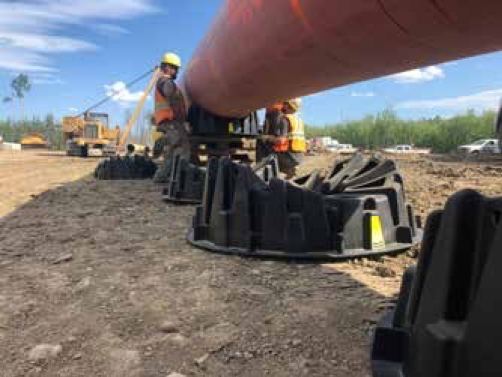
Case one: In-trench pipeline support
Usage:
PipePillo™ structured pipeline supports were used in place of polyurethane foam and sandbags as in-trench pipeline supports to permanently elevate the pipeline from the rocky trench bottom.
Project:
The North Montney Mainline (NMML) project is a 206 km (128 mi.), 1067 mm (42 in.) diameter pipeline in northern British Columbia, Canada. This pipeline connects the liquid rich Montney formation, west of the Alaska highway, to the existing NOVA Gas Transmission Ltd (NGTL) infrastructure. PipePillo™ supports were used on Spread One of the project, located on a challenging section of terrain.
Problem:
The pipeline trench of Spread One was blasted through a shale formation, which resulted in an extremely rough trench bottom. The pipeline required supports to suspend the pipeline from the trench bottom, protecting it from damage and allowing sand padding to surround the pipe. Traditionally, foam pillows or sandbags would have been used in this situation. The remoteness of this site, coupled with the steepness of the trench, made sandbag supports an expensive and cumbersome option. In addition, sandbag supports would have compacted under the weight of the heavy pipe, creating a potential risk for denting and ovality. The foam used for in-trench pipeline support is a lightweight expanding foam similar to what is used for building insulation. For pipeline applications, foam is either sprayed directly into the trench or is preformed into blocks. However, foam is not engineered for compression strength and little testing has been carried out on its effectiveness in protecting pipelines from rock damage.
Foam has also been proven to restrict cathodic protection (CP) systems. As most know, foam is an excellent insulator – this does not bode well with buried pipelines. For these reasons, the owning company did not approve the use of polyurethane foam due to the risk of CP shielding and the questionable long-term integrity of foam.

Solution:
The owning company approved the use of PipePillo™ structured pipeline supports on Spread One to provide permanent support while ensuring the integrity of the cathodic protection system. Third-party testing had confirmed that the PipePillo™ support has negligible cathodic shielding effects when compared to foam. SPPs are incredibly lightweight – the SPP48 used on this project weighs only 19.5 kg (43 lb), light enough to be handled by a single labourer, and has an ultimate load-bearing capacity of 38 400 kg (84 658 lb) per SPP. The SPPs used maintained permanent contact with the pipe, helping to decrease the risk of pipeline ovality by up to 50%.
Outcome:
Workers were able to tie the PipePillo™ structured pipeline supports to the pipe using standard 0.25 in. rope, achieving the desired spacing as calculated by PipeSak® engineers (Figure 1). During installation, all preparation work for PipePillo™ pipeline supports was undertaken out of the trench and completed within a few hours. The side booms lowered the pipeline sections into the trench with the PipePillo™ supports already installed, allowing a full 90° of support and 203 mm (8 in.) of elevation above the rocky trench (Figure 2).
Case two: Pipe storage and fabrication
Usage:
PipePillo™ structured pipeline pillows were used in the pipe yard in place of wooden cribbing for pipe storage, and to support the pipeline during fabrication and welding in both single and stacked configurations.
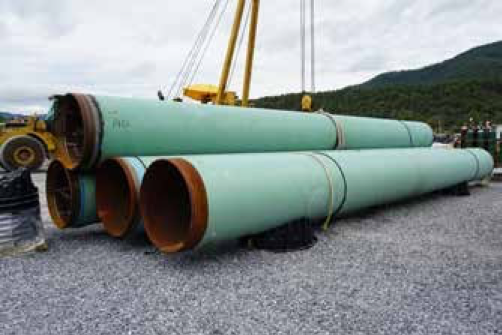
Project:
The Mountain Valley Pipeline (MVP) project is a 1067 mm (42 in.) OD natural gas pipeline scheduled to go into operation mid-2020. The pipeline route spans approximately 473 km (294 mi.) through 16 counties in the states of West Virginia and Virginia. With a capacity of 2 billion ft3/d of natural gas, MVP will play an essential role in providing natural gas to markets in the Mid and South Atlantic regions of the US. The MVP has utilized over 45,000 PipePillo™ structured pipeline pillows to date, in place of foam pillows and sandbags, to support the pipeline in the trench. In addition to in-trench use, PipePillo™ supports are also being utilized by contractors outside of the trench to aid with pipe storage, fabrication, and welding.
Problem:
Standard practice is to use stacked-wood cribbing in the pipe fabrication yard to store the pipe and to support it during fabrication and welding. Stacking wooden skids is a cumbersome and labour-intensive process that poses a significant safety concern in the yard. The pipeline contractor wanted a lower-cost solution that provided reliable and uniform support with multiple height configurations.
Solution:
The PipePillo™ product was an ideal support for all stages of the project’s construction. When used outside the trench, PipePillo™ structured pipeline pillows supported the pipe in both a single and multi-stacked configuration, giving the contractor the freedom to easily adjust the height as required. Each PipePillo™ support has two levels – one being the shipping level, which adds 77 mm (3 in.) to the height. The other is the extended level, which adds 115 – 152 mm (4.5 – 6 in.) to the height of each PipePillo™ support. To achieve the extended level, the second PipePillo™ support was rotated approximately one-eighth turn or 22.5˚ off-centre. Spacing was typically two towers per joint of pipe – much like current wooden skids. The patented, dual frustoconical design gave the SPP good compressive strength and it was used repeatedly in the fabrication yard without compromising strength or durability. They offered 90˚ of support, ensuring the integrity of the pipe was maintained at all times.
Outcome:
PipePillo™ structured pipeline pillows were successfully used in the fabrication yard for pipe storage (Figure 3), inspection, fabrication and welding (Figure 4). Contractors were impressed with the durability of the PipePillo™ product and were able to reuse them over and over in the yard. Ray Steig, one of the contractors from Trinity Energy Services, said that “PipePillo™ supports [had] replaced skids for all of [their] pipe supports. The ease and stackability made it quick and easy to secure large bends. The durability of PipePillo™ product [was] amazing – [they] reuse the same 24 for [their] daily bending.”
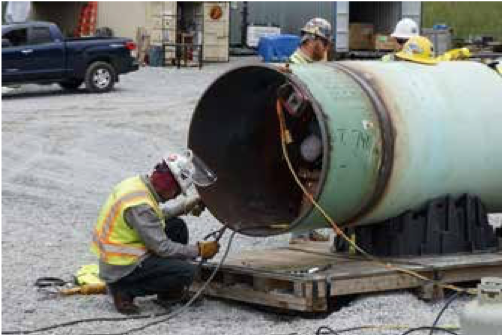
Case three: Pipe stringing and welding
Usage:
PipePillo™ structured pipeline supports were used for low-level stringing of the pipe along the right-of-way in place of wooden cribbing.
Project:
The Brantford to Kirkwall pipeline expansion project was a 1219 mm (48 in.) OD, 14 km (8.7 mi.) expansion to an existing line in southwestern Ontario, Canada. The expansion, beginning in Brantford and terminating at the Kirkwall Valve Site, was part of the Dawn Hub and Dawn Parkway. The Dawn Hub is the largest integrated underground natural gas storage facility in Canada and the second most physically traded hub in North America. The Dawn Hub is strategically located in southwestern Ontario, only 300 km (186 mi.) from the Marcellus and Utica shale basins of the US, which are expected to supply over 40% of the natural gas to the Dawn Hub by 2023. To service the Dawn Hub, Dawn Parkway System consists of 225 km (140 mi.) of parallel 660 mm (26 in.), 864 mm (34 in.), 1067 mm (42 in.) and 1219 mm (48 in.) OD pipelines as well as four mainline compressor stations: Dawn, Lobo, Bright and Parkway.
Problem:
Wooding cribbing is still widely used in North America for temporary pipeline support during stringing and welding. There is no uniform standard for wood cribbing and poorly supported pipe strings can cause serious injuries or even fatalities. Studies have found that the thermal gradient between the two sides of the pipe can cause longitudinal and transversal movements that can lead to pipe instability on wooden cribbing. The owning company wanted to trial a simpler and safer solution for low-level stringing and welding for the large 1219 mm (48 in.) OD pipe.
Solution:
PipePillo™ structured pipeline supports were selected for a number of reasons, primarily its ability to offer a full 90˚ of support, ensuring stability and safety for the pipeline and the pipeline workers. Furthermore, the patented, dual frustoconical design gives the SPP compressive strength while ensuring the pipe is securely supported during slight movements caused by thermal contraction and expansion. Finally, PipePillo™ pipeline supports are manufactured using high-strength polypropylene resins treated with UV inhibitors to ensure durability and longevity from the elements.
Outcome:
PipePillo™ structured pipeline pillows were used to provide controlled and uniform pipeline support along the ROW during stringing and welding. The contractor was able to stack the PipePillo™ supports to achieve additional clearance in 76 mm, 152 mm and 203 mm (3 in., 6 in. and 8 in. respectively) increments. Stacking the SPP supports provided a safe and cost-effective alternative to using wooden skids to support the pipe-stringing and welding process (Figure 5).
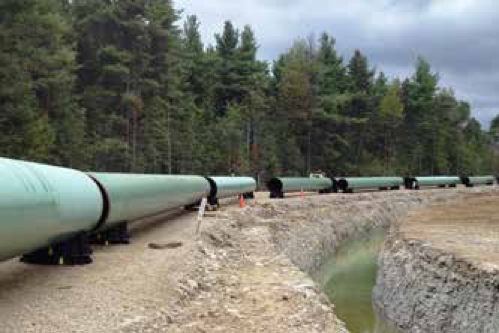
Case four: Integrity and rehabilitation projects
Usage:
PipePillo™ structured pipeline pillows were stacked approximately 3 m (10 ft.) high to provide support with an exposed 1219 mm (48 in.) OD pipeline crossover and valve assembly during an integrity dig.
Project:
The Enbridge Dawn compressor station in southwestern Ontario is a critical component of the Dawn Hub, one of North America’s largest natural gas trading hubs. Natural gas, while being transported through a gas pipeline, needs to be constantly pressurized. A compressor station is a type of ‘pit stop’ for natural gas every 80 – 160 km (50 – 100 mi.) that compresses the gas (increasing pressure) using a turbine or engine and provides a boost to keep the gas moving along. The Dawn compressor station is one of four mainline compressor stations in the 225 km (140 mi.) Dawn Parkway pipeline system and is a critical component to keeping natural gas moving.
Problem:
A below-ground tee and a small section of pipe needed to be replaced with an elbow at the Dawn compressor station. A 1219 mm (48 in.) OD above-ground cross over and valve assembly, weighing approximately 13 600 kg (30 000 lb), needed to be supported approximately 3 m (10 ft.) above ground during the replacement work. The support method used needed to remain in place for several weeks until the replacement work was completed and backfilled. The initial plan was to support the above-ground header using a crane until a custom manufactured support comprised of metal I-beams was put into place. Prior to designing such an expensive and time-consuming solution, the project engineers contacted PipeSak® Incorporated to determine if PipePillo™ structured pipeline supports would be an option for this application.
Solution:
PipePillo™ structured pipeline pillows can be stacked to achieve any height requirement. The stacked PipePillo™ supports can be easily slid under the pipe, making them an ideal solution for integrity digs. The PipePillo™ product design incorporates a dual frustoconical shape which is able to transfer extreme loads effectively through to consolidated or virgin soil beneath. PipePillo™ structured pipeline supports are engineered to last up to 25 years above ground, making it an optimal solution for this above-ground application. In addition to the strength and ease of use, PipePillos™ supports have several cavities that allow water to drain, reducing any risk of corrosion from water pooling.
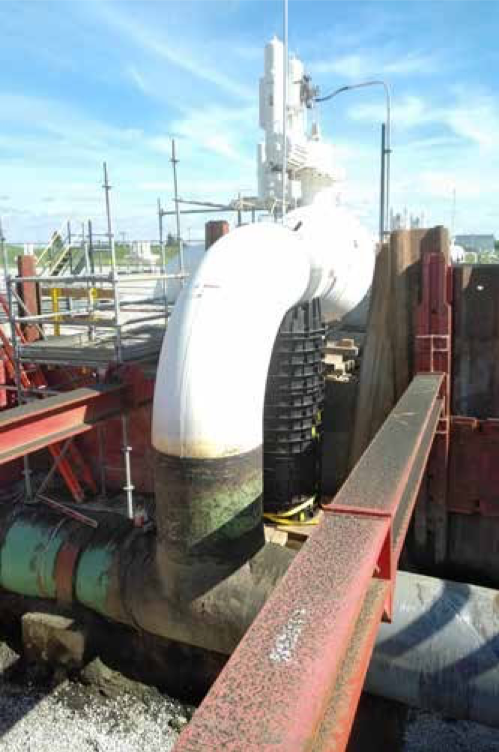
Outcome:
PipeSak® engineers designed a solution utilizing 19 PipePillo™ structured pipeline pillows to support the 1219 mm (48 in.) OD pipe. The SPP48 PipePillo™ supports were stacked up from virgin ground approximately 3 m (10 ft.) (Figure 6). Two additional SPP48s were used to support the buried pipeline during tie-ins. Following the completion of the welding, the replaced section was backfilled to grade – leaving the 19 stacked PipePillo™ supports in place until permanent concrete supports were installed.
Conclusion
PipePillo™ structured pipeline pillows are an engineered, uniform solution for pipeline support – both in and out of the trench. They provide 90˚ of support to limit ovality, and their many cavities support CP systems.
Outside the trench, PipePillo™ supports are well-suited for use during transportation, storage, fabrication, stringing and welding as single or multi-stacked supports. PipePillo™ supports can also be used as an effective means to support exposed pipelines during and following integrity digs. Additional height can be achieved by stacking multiple PipePillo™ supports, limiting the requirement for compacted soil beneath the pipe. PipePillo™ structured pipeline pillows are manufactured from high-strength polypropylene resins which are environmentally inert, yet softer than pipeline coatings.
With five sizes currently available, PipePillo™ structured pipeline pillows can accommodate a wide range of pipe diameters from 60.3 mm (2.375 in.) to 1219 mm (48 in.).